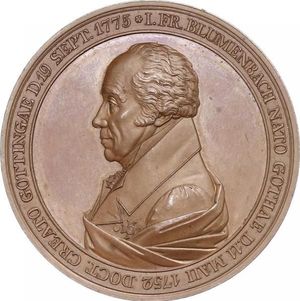|

Medal, commemorating the 50th anniversary of Blumenbach’s doctorate. Front side. Bronze. Private property. Click to enlarge. |
|
| In 1825 Blumenbach celebrated the fiftieth anniversary of his doctorate. On this occasion and on the initiative of former students and of colleagues, a commemorative medal with his portrait was issued (cf. [Rudolphi, Karl Asmund:] Ioanni Fr. Blumenbach … Viro Illustri Germaniae Decori diem semisecularem Physiophili Germanici laete gratulantur : Inest Index Numismatum in virorum de rebus medicis vel physicis meritorum memoriam percussorum. Berolini: s. n., 1825, p. III–IV; digitised version). The medal has a diameter of 49 mm. There is a signature on its reverse („G. Loos dir[exit] H. Gube fec[it]“), which means that the medal was designed by Heinrich Gube (1805–1848) and struck in the “Berliner Medaillen-Anstalt”, whose director was Gottfried Bernhard Loos (1773–1843). Blumenbach was given a specimen made of gold, but exemplars of silver, bronze and iron were also made, the latter one probably of cast iron, as shown by a casting seam in some copies. The medal was produced until at least 1842, cf. Verzeichniß sämtlicher Denk- und Gelegenheitsmünzen, welche aus der Berliner Medaillen-Münze von G. Loos […] hervorgegangen sind. Berlin: E. S. Mittler, 1842, p. 11 no. 7 („können […] ausgeprägt werden“; digitised version (Google Books)). At least of the bronze version, specimens exist in different thicknesses and thus different weights. |
| The circumscription reads, beginning on the front side: |
„I. Fr. Blumenbach nato Gothae d. 11. Maii 1752 doct. creato Gottingae d. 19. Sept. 1775“
[continuation on the back side] „naturae interpreti ossa loqui iubenti physiosophili Germanici d. 19. Sept. 1825.“ |
| Note: In the circumscription of some copies of the iron version, the final “o” is missing in “nato” and “creato”, cf. digitised version of a specimen in the museum of the University of Pittsburg, specimen in the possession of the project “Johann Friedrich Blumenbach – Online”; specimen offered in a Göttingen coin shop in summer 2021. Other specimens, however, have a complete circumscription. |
| Translation: On September 19, 1825, the Naturalists of Germany [dedicate this medal] to Johann Friedrich Blumenbach, born in Gotha on May 11, 1752, who received his doctorate in Göttingen on September 19, 1775, and who is the interpreter of nature, making bones speak. |
| Note: The date of Blumenbach’s doctorate given here (19 Sept. 1775) does not correspond to the date in the doctoral certificate (“Die XVIII Sept. Anno MDCCLXXV Gradum Doctoris Medicinae […...] Contulit”, cf. Dougherty, Frank William Peter: Commercium epistolicum J. F. Blumenbachii. Göttingen: Arbeitsstelle zur Edition des Blumenbach-Briefwechsels, 1984, KatNr. 11, p. 26) and in Göttingische gelehrte Anzeigen 1825, 159. Stück (3 Oct. 1825), p. 1585 („Am. 18. September hatte … “). |
| The front side shows a portrait of Blumenbach in profile, seeing to the left, in frock coat and a toga-like overcoat. On his chest he wears the breast star of a commander of the Guelphen-Orden (Royal Guelphic Order of Hanover) and around his neck the corresponding cross on a ribbon. |
| The portrait with order and ceremonial garment reflects more the conventions of commemorative medals than Blumenbach’s self-image, who does not seem to have attached much importance to elaborate clothing and decorations. This is suggested e.g. by an account of the writer Ludwig Storch (1803–1881), who around 1824 studied for a short time at Göttingen University. Despite all the anecdotal ornamentation, the core of the little narrativ is probably authentic: “Die Mineralogie bildete den Schluß der Vorlesungen; er zeigte dann von allen Steinarten und Metallen im rohen Zustande Exemplare in kleinen Schachteln, […]. Zuletzt kam eine unscheinbare größere Schachtel. […] In der Schachtel waren B’s sämmtliche Orden […]. Aber er trug nie einen am Rocke (nicht einmal das kleinste Bändchen), sie lagen Jahr aus, Jahr ein in der alten Schachtel, um zum Schluß eines Semesters die Reise durch den Hörsal zu machen, begleitet von den spöttischen Bemerkungen ihres Besitzers. Wenn die sämmtlichen Herren Hofräthe der Universität in der Akademie versammelt waren, aufgedonnert, aufgeputzt, die Brust mit bunten Sternen und Kreuzen bepflastert, nahm sich B. in seiner schlichten grauen Tuchjacke und gleichen Beinkleidern (ich habe ihn nie in andern Kleidern gesehen) seltsam genug darunter aus.” (Mineralogy formed the conclusion of the lectures; he then showed specimens of all types of stone and metals in their natural state in small boxes, […]. Finally came an inconspicuous larger box. […] In the box were all the decoration that had been bestowed on B. […]. But he never wore one at the coat (not even the smallest ribbon), all the year they lay in the old box, to make the journey through the lecture room at the end of a term, accompanied by the mocking remarks of their owner. When all the members of the University’s aulic councillors were gathered in the Academy, in full feathers, dressed up, their breasts plastered with colourful stars and crosses, B. in his simple grey cloth jacket and equal trousers (I have never seen him in any other clothes) looked strangely enough among them.) ([Storch, Ludwig:] „Ein in seiner Art einziger ‚Orangutang‘“. In: Die Gartenlaube. Nr. 43 (1857), S. 594–595. Due to the personal nobility associated with the membership in the Guelphic Order, Blumenbach was entitled to use the nobiliary particle “[Ritter] von“, for example on the title pages of his publications or in the signatures in his letters, but he does not seem to have done so. |
|
|

